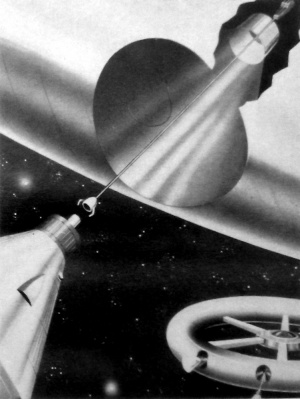Special Projects Applied Research
From The Space Library
Special Projects Applied Research, otherwise known as SPAR Aerospace, was formed out of a merger between the A.V. Roe Canada subsidiary Canadian Applied Research and the De Havilland Canada subsidiary, Special Projects. The merger took place some time after the Avro parent company, Hawker Siddeley purchased the De Havilland group at the end of 1959.
SPAR would become a public company in early 1968. The newly minted public version of SPAR elected to move into more varied fields of opportunity including diving equipment, emergency equipment, gearing, foam making, battery chargers (which evolved from the ISIS satellite program) and many other spin-off products.
The SPAR office was initially located at De Havilland in Downsview Ontario until it moved to the Avro facility in Malton Ontario in 1969.
SPAR evolved into the world's leading purveyor of space robotics in part because of the STEM antenna which had been an enormously successful product for SPAR throughout the 1960s and 70s. Management had been looking for other applications for STEM beyond its most popular use as a long antenna since the early 1960s. In 1963 De Havilland had even proposed a robotic arm, derived from STEM to be used for docking spacecraft.
De Havilland concept art for STEM Robot Arm (c. 1963)
In the early 1970s SPAR was given the contract to build a robotic arm for the forthcoming US manned Space Shuttle. Pressure was enormous on the SPAR team, who were expected to deliver cutting edge technology in time for a drop-dead date for first launch, while simultaneously keeping the Canadian government happy by evolving the spin-off businesses for Canadian industry. SPAR met almost all of their goals on time including passing a critical design review by NASA in 1978. The Remote Manipulator System, nick-named the Canadarm, flew into space in 1981 and provided virtually flawless service to space shuttle crews for the next thirty years.
SPAR went through a long period of expansion and growth during the 1980s and early 1990s. Their collaboration with Hughes Aerospace resulted in a string of satellite successes including the ANIK series, the Brasilsat series and the revolutionary MSAT built for TMI Communications & Company Ltd. of Ottawa.
In the 1980s SPAR became one of the prime contractors for the RADARSAT spacecraft.
However, at the end of 1993 the Board elected to give more autonomy to the four separate sectors of the company, removing some of the immediate decision making from the executive management. By 1995 Space represented only 41% of SPAR's total revenue, the rest being divided amongst Communications, Aviation and Defence and Informatics.
By 1996 problems became evident when sales dropped by $25M over the previous year and the share price dropped by almost half. Many of the problems stemmed from the SPAR Comstream Division in California that was expected to go public, but lost its primary customer.
Between January 1998 and March 1999 an assortment of purchases and sales led to the deconstruction of SPAR Aerospace including the purchase of the robotics division by MDA. Hawker-Siddeley sold some of the fragments of Avro to Magellan Aerospace in 1995, including the Orenda engine plant.
In early 2000, just before the successful launch of Canadarm 2, SPAR would finally be reduced to nothing more than a service company to the aviation industry.

